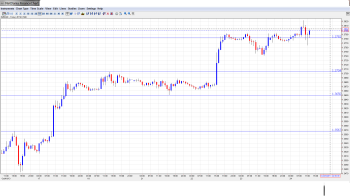EUR/USD remains high in Thursday trading. The pair has dipped below the 1.38 line in Thursday’s European session, as the European PMIs were weak across the board – French, German and Eurozone indicators all missed their estimates. The Spanish Unemployment Rate dropped slightly, to an even 26.0%. It’s a busy day in the US, with three key releases – Unemployment Claims, Trade Balance and New Home Sales.
Here is a quick update on the technical situation, indicators, and market sentiment that moves euro/dollar.
EUR/USD Technical
- In the Asian session, EUR/USD was steady, but pushed higher late in the session, touching a high of 1.3822. The pair could not maintain these gains and consolidated at 1.3806. The pair has dipped below the 1.38 line in the European session.
- Current range: 1.3710 to 1.3800.
Further levels in both directions:
- Below: 1.3710, 1.3650, 1.3570, 1.3500, 1.3460, 1.3415, 1.3325, 1.3240, 1.3175 and 1.3100.
- Above: 1.3800, 1.3870, 1.3940 and 1.4036.
- 1.3710 is providing strong support.
- 1.3800 is a weak line of resistance and was tested earlier. 1.3870 is stronger.
EUR/USD Fundamentals
- 7:00 French Flash Manufacturing PMI. Exp. 50.3, Actual 49.4 points.
- 7:00 French Flash Services PMI. Exp. 51.2, Actual 50.2 points.
- 7:00 Spanish Unemployment Rate. Exp. 26.1 %, Actual 26.0%.
- 7:30 German Flash Manufacturing PMI. Exp. 51.6, Actual 51.5 points.
- 7:30 German Flash Services PMI. Exp. 53.8, Actual 52.3 points.
- 8:00 Eurozone Flash Manufacturing PMI. Exp. 51.4, Actual 51.3 points.
- 8:00 Eurozone Flash Services PMI. Exp. 52.3, Actual 50.9 points.
- Day 1 – EU Economic Summit.
- 12:30 US Trade Balance. Exp. -39.4B.
- 12:30 Unemployment Claims. Exp. 343K.
- 13:00 US Flash Manufacturing PMI. Exp. 52.8 points.
- 14:00 US New Home Sales. Exp. 427K. See how to trade this event with USD/JPY.
- 14:00 US JOLTS Job Openings. Exp. 3.77M.
- 14:30 US Natural Gas Storage. Exp. 80B.
* All times are GMT.
For more events and lines, see the Euro to dollar forecast.
EUR/USD Sentiment
- Euro PMIs disappoint: Euro PMIs started Thursday on a very sour note. PMI numbers from Germany, France and the Eurozone all fell short of their estimates, and most posted a drop compared to the previous release. However, all except French Flash Manufacturing PMI remained above the 50 level, pointing to slight expansion. The latter has not been able to crack above the 50 barrier since January 2012, indicating ongoing contraction in the French manufacturing sector. The euro isn’t much worse for wear after the weak PMIs, and has edged lower against the dollar.
- Non-Farm Payrolls sends dollar down: There was a lot of anticipation leading up to the release of US Non-Farm Payrolls on Tuesday, as the key indicator had been postponed from early October due to the government shutdown. The markets were in for a big disappointment, as NFP slumped to 148 thousand in September, compared to 169 thousand the month before. This was a six-month low, and was nowhere near the estimate of 182 thousand. The US unemployment rate dipped to 7.2%, a five-year low, but this does not point to increased employment, as the participation rate remained at 63.8%, its lowest level since 1978. These figures indicate that the US labor market continues to have difficulty creating new jobs. The US dollar was broadly lower following the weak NFP reading, and the euro took full advantage, gaining about one cent against the retreating dollar.
- Debt ceiling averted, but for how long?: There was some optimism and relief last week, as the Republicans and Democrats finally reached an agreement last week to reopen the government and raise the debt ceiling, following weeks of fighting in Congress. However, the deal provides short-term relief only – the government will be funded until January 15, while the debt limit will be raised until February 7. Both sides have agreed to discuss budget issues and try to reach a long-term agreement before December 13. So we could be right back where we started in just a few months. At the same time, the public is angry at lawmakers for creating the crisis, and with congressional elections only a year away, the politicians on Capitol Hill may think twice before plunging the country into another fiscal and political crisis.
- Fed unlikely to taper QE in 2013: The crisis mood in Washington has cleared for now, but the agreement hammered out in Congress provides short-term relief only, as it raises the debt ceiling until early February and funds the government until mid-January. The underlying budgetary issues remain unresolved, and in this unresolved situation, the Fed is unlikely to push the taper trigger until early 2014. Indeed, some Federal Reserve policymakers have openly said that the Fed won’t take any action this year, citing the budget crisis and decreased consumer confidence in the economy.

